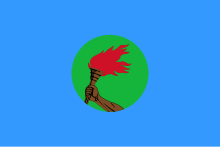National Congress for the Defense of the People
The National Congress for the Defense of the People ( French Congrès national pour la défense du peuple , CNDP ) was a rebel group led by Laurent Nkunda from 2006 to 2009 , allegedly to protect the Tutsi in the Democratic Republic of the Congo . The group was one of the key parties to the conflict in the Third Congo War and is accused of assisting in displacement, killings, rape and crimes against humanity. As part of a peace treaty dated March 23, 2009, the group was recognized as a political party and its armed forces were integrated into the Congolese armed forces . Some of these armed forces, who broke away from the government army in 2012, formed the March 23rd Movement .
aims
The main goal of the CNDP was initially to protect the Congolese Tutsi from the Rwandan Hutu militias of the FDLR, whose functionaries were responsible for the 1994 genocide in Rwanda. Later, the CNDP leader Laurent Nkunda tried to make the CNDP a multi-ethnic, all-Congolese political alternative. Rwanda has been accused of using the CNDP as a proxy to intervene in neighboring country affairs.
history
According to its own information, the CNDP was founded in 2006. In August 2008, the CNDP displaced more than a quarter of a million people in a large-scale offensive. Human rights groups accuse the CNDP of killing, rape and torture. As a party to the conflict, however, the rebels of the CNDP were viewed as much more disciplined than the looting government troops and the Maj-Maj militias allied with them.
In early January 2009, CNDP leader Laurent Nkunda was overthrown by his military chief Bosco Ntaganda . Ntaganda allied itself with the Congolese government and jointly took action against the Hutu militia FDLR . On January 22, 2009, the fugitive Laurent Nkunda was arrested by Rwandan forces.
The soldiers of the CNDP, now without leadership, agreed six days later (on January 29, 2009) to join the government army in order to jointly take action against the FDLR (especially in the North Kivu region). The number of soldiers is estimated at around 6,200. According to the government, these should be fully integrated by February 2. Only a few hundred CNDP fighters have so far been integrated into the national army.
On March 23, 2009, in Goma , representatives of the CNDP signed a UN-negotiated peace agreement with the government that transforms it into a legal political organization. The March 23 Movement, founded in April 2012 , justifies its separation from the Congolese government army FARDC with dissatisfaction with the implementation of this agreement and named itself after the date of conclusion.
swell
- ↑ Washington Post, August 5, 2007.
- ↑ Interim report of the Group of Experts on the DRC submitted in accordance with paragraph 4 of Security Council resolution 2021 (2011)
- ↑ http://news.bbc.co.uk/2/hi/africa/7834750.stm
- ↑ Archived copy ( Memento of December 2, 2008 in the Internet Archive )
- ↑ a b http://news.bbc.co.uk/2/hi/africa/7812504.stm
- ↑ Power struggle before peace round , the daily newspaper , January 7, 2009.
- ↑ Congo: Rebels split ( page no longer available , search in web archives ) Info: The link was automatically marked as defective. Please check the link according to the instructions and then remove this notice. , Wiener Zeitung , January 21, 2009.
- ↑ Tagesschau : Rebel leader Nkunda arrested ( memento of July 31, 2010 in the Internet Archive ) of January 23, 2009.
- ↑ CNDP joins government forces , The New Times (Rwanda), Jan. 30, 2009.
- ↑ Integration of rebel troops to continue , The New Times (Rwanda), January 31, 2009.
- ^ Peace Accords in Eastern Congo , Der Standard , March 23, 2009.
Web links
- Congrès national pour la défense du peuple - official website (English, French)
- The "Seven Point Program of the CNDP"
